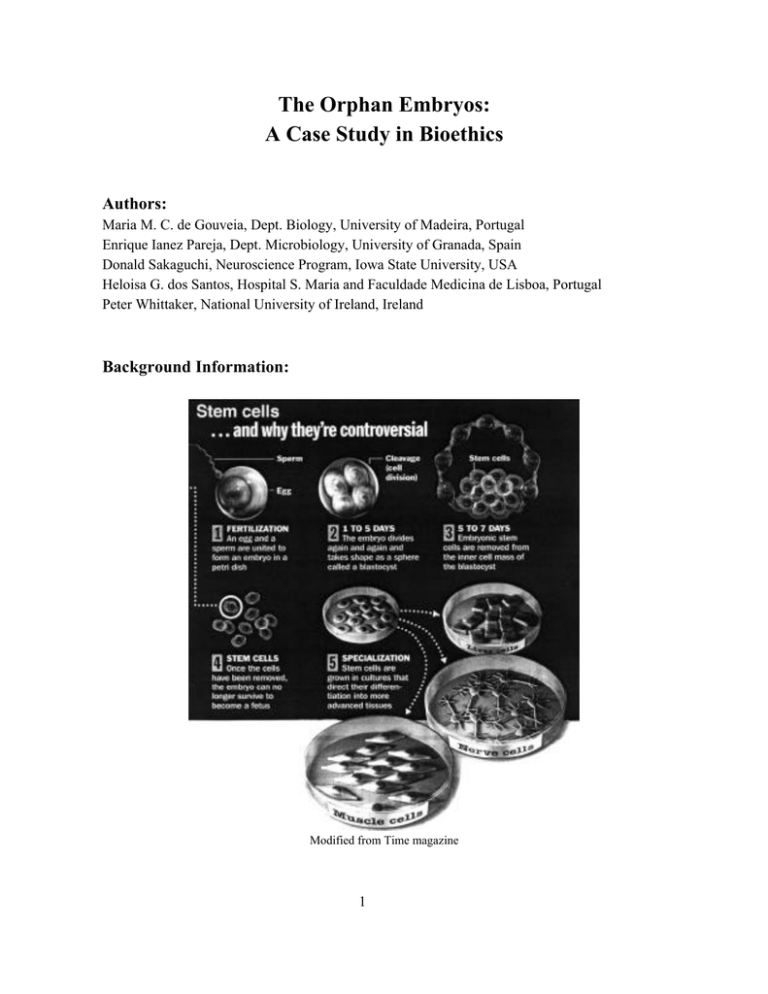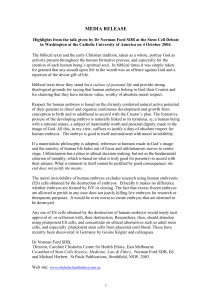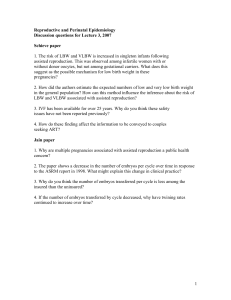The Orphan Embryos: A Case Study in Bioethics Authors:
advertisement

The Orphan Embryos: A Case Study in Bioethics Authors: Maria M. C. de Gouveia, Dept. Biology, University of Madeira, Portugal Enrique Ianez Pareja, Dept. Microbiology, University of Granada, Spain Donald Sakaguchi, Neuroscience Program, Iowa State University, USA Heloisa G. dos Santos, Hospital S. Maria and Faculdade Medicina de Lisboa, Portugal Peter Whittaker, National University of Ireland, Ireland Background Information: Modified from Time magazine 1 Following fertilization, a human egg divides several times during the first few days to produce a spherical mass of undifferentiated cells. During this stage the cells are totipotent, i.e. they are each able to give rise to an embryo. In the next stage some of the cells of the embryo give rise to what is called the inner cell mass. These cells are no longer totipotent. The cells can be removed from the embryo and grown in culture. The resultant cells are referred to as embryonic stem cells. (Removal of the cells from the embryo at this stage causes its destruction). In culture the embryonic stem cells can be induced to differentiate into several types of specialized cell (e.g. muscle, nerve, liver). It is expected that in the future these cells will be able to be used for treatment of degenerative diseases (including Parkinson’s disease) and some injuries. Case Study: Five years ago, Mr. and Mrs. Smith were presented to an in vitro fertilization (IVF) clinic in their local hospital. After a number of attempts, eight eggs were successfully fertilized. Three of these were implanted and eight months later Mrs. Smith gave birth to twins, but only one baby survived. The Smith's requested that the surplus embryos be frozen for possible further implantation at a later stage. No further possibilities for use of the embryos were suggested at this time by the hospital staff. Tragically Mr. and Mrs. Smith died in an automobile accident one-year later. Two years after this the IVF clinic tried to contact the couple to determine their wishes concerning the disposition of the frozen embryos, and at this stage learned of their deaths. In the hospital there was a research group actively researching therapies for Parkinson’s disease. They had already presented a proposal to the hospital Ethics Committee to be allowed to use stem cells derived from frozen embryos for research in Parkinson’s disease therapy and the project had been approved. The Director of the research team approached the IVF clinic to see whether they had surplus frozen embryos that they might use. The head of this clinic offered the surplus Smith embryos to the Director of the research team. In the country where this happened, there is no clear legislation concerning embryo stem cell research. As a group please answer the following questions. Although you may not agree, your group must come to a consensus answer for each question. Completely answer each question before proceeding to the next question. 2 Questions: answer each question in order before proceeding to the next question. 1. Do you see any ethical concerns associated with this situation (yes/no)? Please list some of your concerns in the space provided. 2. If you had been a member of the Ethics Committee would you have supported the use of embryos to produce embryonic stem cells for research into Parkinson’s disease? 3. Construct a valid ethical argument either for or against the destruction of the human embryos to produce stem cells. If your group did not agree on the answer to question 2, write arguments both for and against. 4. Did the IVF clinic head act ethically in handing over the Smith's embryos to the Parkinson’s disease research team (yes/no)? 5. Ethically justify your answer to question 4. If your group did not agree, write arguments both for and against. 6. What other options could there have been for the fate of the embryos? 3 7. What order would you give to the ethical acceptability to the following possible uses of the embryos? a) b) c) d) e) Do nothing (keep embryos frozen) Destroy the embryos Offer the embryos for “adoption” by another family Sell the embryos to a commercial company working in embryonic stem cells Allowed the embryos to be used for publicly funded research into Parkinson’s disease. 8. Give ethical considerations that justify your first and last choices from question 7. 4






